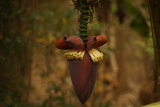
Our first stop was to the edge of the Ngorongoro crater. We didn’t go down into the crater, but they say we will on our way back from the Serengeti. This is an ancient, extinct volcano crater. Its banks are pretty steep.
19 October 2017 Thursday - Drive to Serengeti ~ Day 10
Today was a slow day. We basically spent all day driving to the Serengeti. It was not without its highlights and events, however. And we still took a lot of photos, although not as many as some days. The whole day was frustrating for me because every animal we saw was on the left side of the rover where Kathy was sitting. I was sitting on the right side, so I didn’t get many good shots. By the end of the day it was ridiculous and I was very frustrated. I even asked Eki, “How did you manage to get all the animals on that side of the vehicle?”
The first photo is the flower of a banana tree. I think I posted one of those earlier.

Our
first stop was to the edge of the Ngorongoro crater. We didn’t go
down into the crater, but they say we will on our way back from the
Serengeti. This is an ancient, extinct volcano crater. Its banks are
pretty steep.
It has its own mini-ecosystem, complete with different groups of animals like the other parks. It’s not that big either. From the overlook, all we could see was a big dry plains. At the bottom, we could see herds of animals. For example, this photo contains a herd of cape buffalo, but they’re so far away, they look like tiny dots at the center.
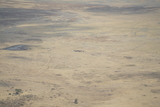
I
took a photo of Kathy standing at the railing, overlooking the
crater.
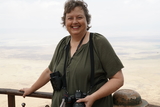
Kathy,
of course, took mine too.
We continued driving toward the Serengeti, and saw various animals. In some cases, hungry animals like giraffes climbed to the top of the crater to find better food.
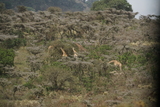
We
also saw an ostrich. On Kathy’s side of the vehicle.
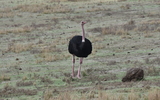
We
saw giraffes. On Kathy’s side of the vehicle.
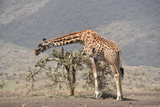
It
wasn’t just animals we saw. We also saw people. We saw a
cool-looking Maasai village built in a pretty valley. On Kathy’s
side of the vehicle.
We came across another group of painted teenage Maasai boys who had undergone circumcision. On Kathy’s side of the vehicle. We didn’t stop for them, though, like we did a few days ago.
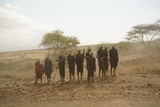
We
encountered another group of boys who had somehow managed to kill a
black mamba snake. On Kathy’s side of the vehicle.
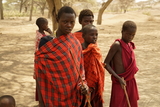
I
remember hearing about black mambas when we were in Botswana years
ago. They were supposedly very deadly and aggressive.
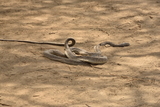
We
saw lots of Maasai cattle herders taking their cows and/or goats out
to graze.
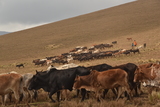
Kathy
took some really good shots of a Maasai man with a cool skull-jacket.
He was carrying a traditional spear (they need some defense from the
predators roaming around) and walking stick. He was cool. On her side
of the vehicle.
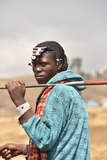
She
also got this photo of a woman with a baby and an overloaded donkey.
As we drove across the Tanzanian countryside, we saw vast stretches of land that were empty, except for the dust devils. The terrain became more hilly, and as we gained in elevation, it became somewhat cooler. Not uncomfortably cold, but a welcomed relief from the scorching sun.
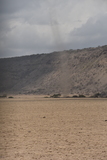
Eventually,
we descended again, and it became hot again. Remarkably, I saw a
cloud that looked like the head of a bear with its mouth open.
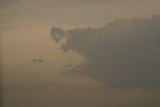
After
a long ride, we stopped at the Olduvai Gorge Museum, which is famous
for the work of Mary Leaky, a pioneer in anthropology. The gorge was
a big hole in the group that looked like this:
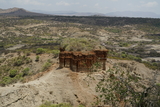
At
this site in 1959, they discovered and started excavating the bones
of lots of ancient pre-humans. I didn’t realize so many of them had
been found in Tanzania.
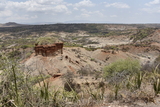
What
struck me was how many of these ancient ancestors there were. I
thought maybe there were five or fix ancient pre-human specimens
found. I was wrong. There are actually lots of species, which were
highlighted in this chart:
The museum was filled with original and replica s
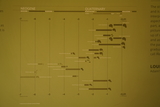
This
map of Africa shows roughly where our ancient ancestors were
discovered.
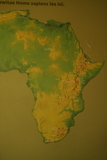
The
museum had lots of skeletons and skulls from ancient evolutionary
ancestors of humans. Some of them were real and some were
reproductions. It was hard to tell which was which. They were all
kept in glass enclosures to protect them.
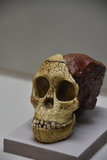
The
skulls were all different, and they all represented different points
of the human evolutionary tree.
What surprised me most was a reproduction of the famous “Lucy” skeleton. Since “Lucy” was discovered at a different site, the original was not at this museum. What surprised me was her size: She was just three feet (one meter) tall!
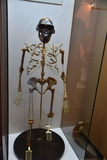
Lucy
was 3.2 million years old, and only 40 percent complete. The other 60
percent was obvious a black-colored frame to illustrate what the
complete skeleton looked like.
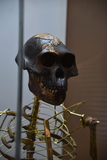
Other
skeletons were tall, and obvious muscular. This one, the “nutcracker
man,” was 1.8 million years old.
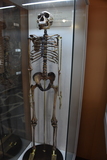
After
a long lecture about the site, we ate lunch, then headed back on the
range rovers. Finally, we reached the gates of Serengeti National
Park. Because there were 15 of us travelers, plus three guides, we
had three land rovers. We had to stop and register the vehicles, and
there was a long line.
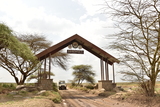
Near
the entrance, we saw our first Serengeti animal: a weird looking
bird.
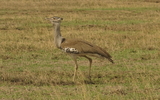
We
got out of the vehicles and took a walk up a big hill that overlooked
the park. There were more of those strange lizards that were pink,
orange, blue, and purple. They were so beautiful. I followed one
around and took lots of photos of it.
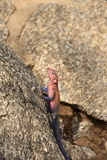
From
the top of the hill we could see for miles. The Serengeti looked like
a vast brown desert. It was parched.
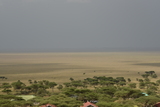
The
edge, where the park entrance was located, was a little more green
and lush. Barely.
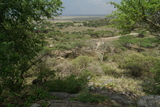
Some
friends took our photo at the overlook.
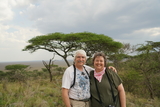
Because
of the dryness, there was lots of dust. Because of all the dust,
Kathy was wearing a scarf she could use to cover her mouth. At one
point, we used it to pull her hair up. I told her she looked like
Rosy the Riveter and got her to pose for me.
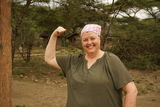
Eventually,
they got our park permit straightened out and we got back in the
range rovers. We drove for miles down a long and dusty dirt road. A
huge grater was trying to fix the road, but all he was doing was
moving piles of dirt and rocks around, which made it hard for the
drivers.
When we got deeper into the park, we started seeing animals again. We saw some vultures sitting in a tree. They were far away, so I couldn’t get a very good shot. This photo is zoomed in.
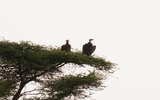
Then,
magically, it started raining. We saw vast herds of wet wildebeests.
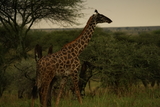
We
saw a wet cape buffalo up close that had gotten into some big sand
burrs. Poor thing!
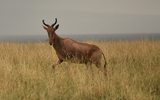
All
this rain started making the roads very messy, muddy, and slippery.
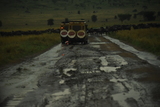
As
we headed to the OAT tented camp, the rain got heavy. Eventually, the
roads became rivers. It looked like we were literally driving down
rivers, not roads.
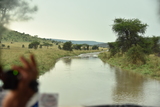
The
rain stopped and we reached the camp before it got dark. The tents
were much more rustic than the tents in Botswana, but that added to
the charm. They told us not to go out after dark without an escort.
The reason was very obvious, as we saw cape buffaloes walking around
near the tents. Dangerous. Here is a photo of the bathroom sink:
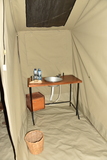
Here’s
the main room of the tent.

Our
Swahili word for the day is “Asanti” which means “Thanks.”
Often “Asanti Sana” which is “Thank you.”
That’s all for now.